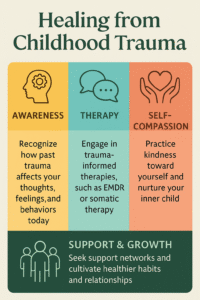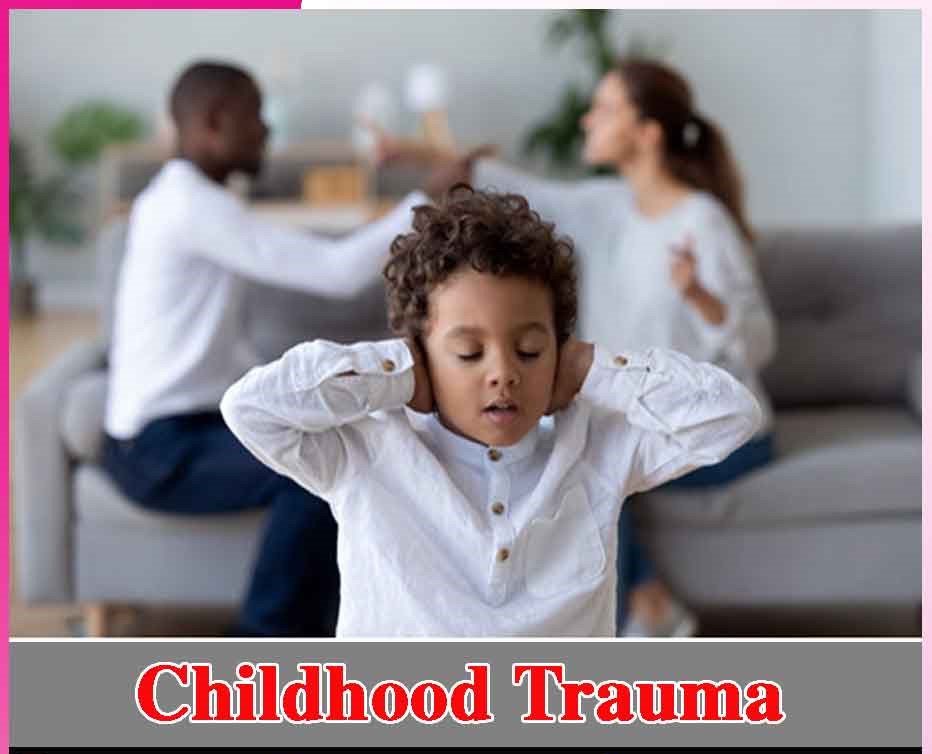Childhood experiences with trauma, such as neglect, abuse, or family conflict, can lead to emotional patterns that carry into adulthood, affecting trust, communication, and closeness. Many people repeat cycles such as people-pleasing, emotional withdrawal, or fear of abandonment without realizing these are learned coping mechanisms. The good news is that healing is possible. Recognizing how the past influences present relationships is the first step. In this discussion, I’ll share how childhood trauma shapes adult connections and ways to build trust, emotional safety, and healthier bonds.
Understanding Childhood Trauma and Its Lasting Effects
Childhood trauma isn’t just about significant, dramatic events. It can be about ongoing emotional neglect, unpredictable caregivers, bullying, or simply not having someone supportive during stressful times. When these experiences keep happening or are overlooked, they impact how someone learns to trust, handle stress, and express their emotions or needs.
Research points out that adverse childhood experiences (often called ACEs) lead to changes in brain development and how kids learn to cope. The ACEs study by the CDC and Kaiser Permanente made clear links between early trauma and later issues with physical health, mental well-being, and relationships.
Brains are adaptable, but if they have to work overtime to handle ongoing stress, responses like fight, flight, or freeze can become the go-to reaction. These survival skills are a lifeline in a rough childhood, but they often get in the way of building and keeping close relationships as an adult.
How Childhood Trauma Shows Up in Adult Relationships
Unresolved trauma tends to make itself felt in love, friendships, and even at work—in ways that aren’t always obvious right away. Here are some common patterns I’ve noticed or heard about from folks on the road to healing:
- Difficulty Trusting Others: People who had unreliable or unsafe adults in childhood often figure they can’t count on anyone. As adults, opening up or relying on others feels risky.
- Poor Boundaries: If boundaries were ignored or crossed as a kid, it’s confusing to know how to draw the line as an adult—sometimes people become distant, and other times, they overgive.
- Fear of Abandonment: Experiencing loss, neglect, or unpredictability can spark real anxiety about being left. This often shows up as clinginess, jealousy, or people-pleasing.
- Difficulty Expressing Emotions: Kids who got in trouble for sharing their true feelings often grow up to hide their emotions even from themselves, making honest communication challenging.
- Cycles of Toxic or Unfulfilling Relationships: Sometimes, old, chaotic patterns feel more ‘normal’ than safe; people can drift back to what’s familiar, even when it isn’t good for them.
These patterns happen because they made sense as survival skills. But with time and care, they can change.
Common Challenges and How to Manage Them
The first step is spotting how trauma shows up. But real progress means learning new ways to connect. Here’s what gets in the way for many people, plus a few helpful tips:
- Emotional Triggers: Old emotional wounds can pop up unexpectedly. Something a friend or partner says or does might feel like a threat, or their distance may bring back a deep fear of abandonment. Getting mindful about your triggers—maybe through journaling or talking with a therapist—can make a difference.
- Conflict Avoidance or Escalation: Some avoid conflict at all costs, while others turn minor disagreements into big blowups. Learning to see conflict as a regular part of connection and not a sign of disaster helps change this pattern. Practicing healthy conflict skills smooths the way.
- Struggling With Intimacy: Letting someone close is scary after being hurt. Taking it slow and celebrating baby steps—like sharing a feeling or accepting help—helps rebuild trust bit by bit.
- Anxiety or Keeping an Eye Out: Waiting for things to go wrong is draining. Building self-soothing habits, such as grounding exercises or deep breathing, gives your nervous system space to calm down and feel safer.
Building Healthier Relationships After Trauma
Healing from childhood trauma isn’t about forgetting what happened. It’s about figuring out how to respond differently, now that you’re safe. A few habits and supports make a real difference in repairing your relationship patterns:
- Therapy and Support: Reaching out to trauma-informed therapists, support groups, or self-help books provides good tools for managing triggers and growing your connection skills. Therapies like EMDR or cognitive-behavioral therapy and somatic approaches really help people process and heal trauma.
- Setting and Respecting Boundaries: Learning to say “no,” ask for space, or tell others what you need is hard but strengthens connections. Respecting another person’s limits builds trust, too.
- Self-compassion: Many survivors have a harsh inner critic. Being gentle with yourself and accepting mistakes helps soften shame and allows healing.
- Open Communication: Honesty about your needs, disappointments, or triggers is tough, but practicing helps build stronger, safer relationships.
- Building a Solid Support Network: Trusted friends, chosen family, or supportive online communities give encouragement and understanding. This can mean a lot if your biological family isn’t healthy.
Real-Life Examples and Stories
I know people who’ve turned toxic relationship patterns around, just one step at a time. One friend, who always shut down during arguments, learned to say, “I need some time to process” instead of ghosting. Another person realized they always dated emotionally distant folks. After some reflection, they started looking for emotional availability early on and held out for genuine openness.
Stories like these aren’t quick fixes. They show how even small changes, repeated over time, can help create safer, closer, and more satisfying relationships.
Self-Check: Signs You’re Feeling the Impact
- Do you expect others to disappoint you, even when they haven’t?
- Does talking about how you feel seem pointless or too hard?
- Do most of your closest relationships involve drama or ups and downs?
- Do you get anxious when someone important pulls away or sets a limit?
- Is believing you’re worthy of love or care an ongoing struggle?
If you said yes to several, remember you’re not broken. You developed these responses to get by in hard times. With practice and support, you can switch things up and create new ways of relating to others.
Frequently Asked Questions
Here’s what people often ask when working through these patterns:
Question: Is it possible to have healthy relationships after childhood trauma?
Answer: Definitely. Healing usually takes time and effort, but many build stable, happy connections after changing old habits and getting support.
Question: How can I break the cycle of choosing unhealthy partners?
Answer: Learn what healthy relationships look and feel like. Set clear standards for how you want to be treated and stick to them, even if it initially feels awkward. Over time, your choices will grow healthier.
Question: When should I seek professional help?
Answer: If trauma keeps getting in the way of daily life or relationships, or you notice the same painful patterns coming back again and again, talking to a trauma-informed therapist can offer new tools and support.
Practical Tips for Moving Forward
Building safe, rewarding relationships after trauma is an ongoing adventure, not a race. Here are some tips to help along the way:
- Track Your Growth: Celebrate small wins, such as being honest about your needs or setting a healthy limit.
- Stay Curious: When old coping habits appear, notice them without judging yourself. Curiosity is a lot more helpful than criticism.
- Focus on the Present: You can’t change your past, but every new situation allows you to react differently.
- Reach Out for Support: A mentor, support group, or mental health pro can be a game-changer. Building connections, even slowly, can help you heal.
Working through the effects of childhood trauma isn’t about aiming for perfection. It’s about making small, steady choices that help you build the close relationships you want. Each positive change adds more security, connection, and warmth to your life. Things can improve no matter where you begin—with time, support, and self-compassion.
Video:

